Graphene H-Waveguide for Terahertz Lasing Applications: Electromagnetic Quasi-Linear Theory
Abstract
:1. Introduction
2. Proposed Graphene Component, Its Theory, and Used Methods
2.1. Hybrid Mode Theory
2.2. Modes
2.3. Modes
3. Results and Discussion
3.1. Graphene Conductivity
3.2. TEy Longitudinal Propagation Constant
3.3. Study of the Bound and Leaky Regimes of the TEy and TMy Modes
3.4. Controlling the Modes Varying the Parameters of Graphene H-Waveguides
3.5. Conductor Loss Calculation in Graphene H-waveguide
3.6. Longitudinal Field Dependence
4. Conclusions
Funding
Acknowledgments
Conflicts of Interest
References
- Geim, A.K.; Novoselov, K.S. The rise of graphene. Nat. Mater. 2007, 6, 183–191. [Google Scholar] [CrossRef]
- Heydari, M.B.; Samiei, M.H.V. Plasmonic graphene waveguides: A literature review. arXiv 2018, arXiv:1809.09937. [Google Scholar]
- Gusynin, V.; Sharapov, S.; Carbotte, J. Magneto-optical conductivity in graphene. J. Phys. Cond. Matt. 2006, 19, 026222. [Google Scholar] [CrossRef] [Green Version]
- Falkovsky, L.A.; Varlamov, A.A. Space-time conductivity of graphene. Eur. Phys. J. B 2007, 56, 281–284. [Google Scholar] [CrossRef] [Green Version]
- Dubinov, A.A.; Aleshkin, V.Y.; Mitin, V.; Otsuji, T.; Ryzhii, V. Terahertz surface plasmons in optically pumped graphene structures. J. Phys. Cond. Matt. 2011, 23, 145302. [Google Scholar] [CrossRef] [PubMed] [Green Version]
- Lovat, G.; Hanson, G.W.; Araneo, R.; Burghignoli, P. Comparison of spatially dispersive models for dyadic intraband conductivity of graphene. In Proceedings of the 2013 7th European Conference on Antennas and Propagation (EuCAP), Gothenburg, Sweden, 8–12 April 2013; IEEE: Piscataway, NJ, USA, 2013; pp. 500–504. [Google Scholar]
- Hanson, G.W. Quasi-transverse electromagnetic modes supported by a graphene parallel-plate waveguide. J. Appl. Phys. 2008, 104, 084314. [Google Scholar] [CrossRef]
- Kouzaev, G.A. Physics-based analytical engineering models of graphene micro- and nanostrip lines. IEEE Trans. Compon. Packag. Manuf. Technol. 2019, 9, 2442–2450. [Google Scholar] [CrossRef]
- Lovat, G.; Burghignoli, P.; Araneo, R. Low-frequency dominant mode propagation in spatially dispersive graphene nanowaveguides. IEEE Trans. Electromagn. Compat. 2013, 55, 328–333. [Google Scholar] [CrossRef]
- Lovat, G.; Ye, D.; Burghignoli, P.; Araneo, R.; Wei, X.-C. Theoretical study of the first higher order mode in grounded graphene nanoribbons. IEEE Trans. Nanotech. 2018, 17, 814–823. [Google Scholar] [CrossRef]
- Shao, Y.; Yang, J.J.; Huang, M. A review of computational electromagnetic methods for graphene modeling. Int. J. Antennas Propag. 2016, 2016, 7478621. [Google Scholar] [CrossRef] [Green Version]
- Yang, J.; Hu, P.; Yu, G. Perspective of graphene-based electronic devices: Graphene synthesis and diverse applications. APL Mater. 2019, 7, 020901. [Google Scholar] [CrossRef] [Green Version]
- Otsuji, T.; Tombet, S.A.B.; Satou, A.; Fukidome, H.; Suemitsu, M.; Sano, E.; Popov, V.; Ryzhii, M.; Ryzhii, V. Graphene-based devices in terahertz science and technology. J. Phys. D 2012, 45, 303001. [Google Scholar] [CrossRef]
- Makeeva, G.S.; Golovanov, O.A.; Kouzaev, G.A. Numerical analysis of tunable parametric terahertz devices based on graphene nanostructures using the projection method and autonomous blocks. Proc. AIP Conf. 2017, 1863, 390003. [Google Scholar]
- Lerer, A.M.; Makeeva, G.S.; Kouzaev, G.A. Electrodynamic and probabilistic calculation of performances of THz devices based on periodic multilayer graphene-dielectric structures. In Proceedings of the Moscow IEEE Workshop on Electronic and Networking Technologies (MWENT), Moscow, Russia, 11–13 March 2020. [Google Scholar]
- Ooi, K.J.A.; Tan, D.T.H. Nonlinear graphene plasmonics. Proc. R. Soc. A 2017, 473, 20170433. [Google Scholar] [CrossRef] [Green Version]
- Bozzi, M.; Pierantoni, L.; Bellucci, S. Application of graphene at microwave frequencies. Radioengineering 2015, 24, 661–669. [Google Scholar] [CrossRef]
- Ryzhii, V.; Ryzhii, M.; Otsuji, T. Negative dynamic conductivity of graphene with optical pumping. J. Appl. Phys. 2007, 101, 083114. [Google Scholar] [CrossRef]
- Rana, F. Graphene terahertz plasmon oscillators. IEEE Trans. Nanotechnol. 2008, 7, 91–99. [Google Scholar] [CrossRef] [Green Version]
- Ryzhii, M.; Ryzhii, V. Injection and population inversion in electrically induced p–n junction in graphene with split gates. Jpn. J. Appl. Phys. 2007, 46, L151. [Google Scholar] [CrossRef]
- Popov, V.V.; Polischuk, O.V.; Davoyan, A.R.; Ryzhii, V.; Otsuji, T.; Shur, M.S. Plasmonic terahertz lasing in an array of graphene nanocavities. Phys. Rev. B 2012, 86, 195437. [Google Scholar] [CrossRef]
- Ryzhii, V.; Dubinov, A.A.; Otsuji, T.; Mitin, V.; Shur, M.S. Terahertz lasers based on optically pumped multiple graphene structures with slot-line and dielectric waveguides. J. Appl. Phys. 2010, 107, 054505. [Google Scholar] [CrossRef] [Green Version]
- Chai, J.; Hu, P.; Ge, L.; Xiang, H.; Han, D. Tunable terahertz cloaking and lasing by the optically pumped graphene wrapped on a dielectric cylinder. J. Phys. Commun. 2019, 3, 035016. [Google Scholar] [CrossRef]
- He, X.Q.; Ning, T.G.; Pei, L.; Zheng, J.J.; Li, J.; Wen, X.D. Tunable hybridization of graphene plasmons and dielectric modes for highly confined light transmit at terahertz wavelength. Opt. Express 2019, 27, 5961–5972. [Google Scholar] [CrossRef] [PubMed]
- Ryzhii, V.; Ryzhii, M.; Sato, A.; Otsuji, T.; Dubinov, A.A.; Aleshkin, V.Y. Feasibility of terahertz lasing in optically pumped epitaxial multiple graphene layer structures. J. Appl. Phys. 2009, 106, 084507. [Google Scholar] [CrossRef] [Green Version]
- Kumbhare, V.R.; Paltani, P.P.; Majumder, M.K. Future of graphene based interconnect technology—A reality or a distant dream. In Proceedings of the 2018 5th IEEE Uttar Pradesh Section International Conference on Electrical, Electronics and Computer Engineering (UPCON), Gorakhpur, India, 2–4 November 2018; IEEE: Piscataway, NJ, USA, 2018; pp. 1–7. [Google Scholar]
- Morozov, M.Y.; Leiman, V.G.; Popov, V.V.; Mitin, V.; Shur, M.S.; Karasik, V.E.; Ryzhii, M.; Otsuji, T.; Ryzhii, V. Optical pumping in graphene-based terahertz/far-infrared superluminescent and laser heterostructures with graded-gap black-PxAs1-x absorbing-cooling layers. Opt. Eng. 2019, 59, 0061606. [Google Scholar] [CrossRef]
- Lee, K.W.; Jang, C.W.; Shin, D.H.; Kim, J.M.; Kang, S.S.; Lee, D.H.; Kim, S.; Choi, S.-H.; Hwang, E. Light-induced negative differential resistance in graphene/Si-quantum-dot tunneling diodes. Sci. Rep. 2015, 6, 30669. [Google Scholar] [CrossRef] [Green Version]
- Li, H.; Yan, M.; Wan, W.; Zhou, T.; Zhou, K.; Li, Z.; Cao, J.; Yu, Q.; Zhang, K.; Li, M.; et al. Graphene-coupled terahertz semiconductor lasers for enhanced passive frequency comb operation. Adv. Sci. 2019, 6, 1900460. [Google Scholar] [CrossRef]
- Ryzhii, V.; Otsuji, T.; Shur, M. Graphene based plasma-wave devices for terhahertz applications. Appl. Phys. Lett. 2020, 116, 140501. [Google Scholar] [CrossRef] [Green Version]
- Quispe, H.O.C.; Encomendero-Risko, J.J.; Xing, H.G.; Sensale-Rodriguez, B. Terahertz amplification in RTD-gated HEMTs with a grating-gate wave coupling topology. Appl. Phys. Lett. 2016, 109, 063111. [Google Scholar] [CrossRef] [Green Version]
- Mao, X.; Xie, S.; Zhu, C.; Geng, Z.; Chen, H. Theoretical study of terahertz active transmission line oscillator based on RTD-gated HEMT. AIP Adv. 2018, 8, 065323. [Google Scholar] [CrossRef]
- Ahi, K. Review of GAN-based devices for terahertz operation. Opt. Eng. 2017, 56, 090901. [Google Scholar] [CrossRef]
- Mitrofanov, O.; James, R.; Fernández, F.; Mavrogordatos, T.K.; Harrington, J.A. Reducing transmission losses in hollow THz waveguides. IEEE Trans. Terahertz Sci. Technol. 2011, 1, 124–132. [Google Scholar] [CrossRef] [Green Version]
- Tischer, F.J. Properties of the H-guide at microwave and millimeter-wave regions. Proc. IEE Part B Electron. Commun. Eng. 1959, 106, 47–53. [Google Scholar] [CrossRef]
- Yoneyama, T.; Nishida, S. Non-radiative dielectric waveguide for millimeter-wave integrated circuits. IEEE Trans. Microw. Theory Tech. 1981, 29, 1188–1192. [Google Scholar] [CrossRef]
- Kuroki, F.; Ohta, H.; Yoneyama, T. Transmission characteristics of NRD guide as a transmission medium in THz frequency band. In Proceedings of the 2005 Joint 30th International Conference on Infrared and Millimeter Waves and 13th International Conference on Terahertz Electronics, Williamsburg, VA, USA, 19–23 September 2005; IEEE: Piscataway, NJ, USA, 2005; Volume 2, pp. 331–332. [Google Scholar]
- Ye, L.; Xu, R.; Wang, Z.; Lin, W. A novel broadband coaxial probe to parallel plate dielectric waveguide transition at THz frequency. Opt. Express 2010, 18, 21725–21731. [Google Scholar] [CrossRef] [PubMed]
- Sesao, K.; Monnai, Y. Variable terahertz attenuator integrated on non-radiative guide using photoinduced carriers. IEEE Trans. Terahertz Sci. Technul. 2020, 10, 256–259. [Google Scholar] [CrossRef]
- Meixner, J. The behavior of electromagnetic fields at edges. IEEE Trans. Antennas Propag. 1972, 20, 442–446. [Google Scholar] [CrossRef]
- Balandin, A.A. Thermal properties of graphene and nanostructured carbon materials. Nat. Mater. 2011, 10, 569–581. [Google Scholar] [CrossRef] [Green Version]
- Balanis, C.A. Advanced Engineering Electromagnetics; John Willey & Sons, Inc.: Hoboken, NJ, USA, 1989. [Google Scholar]
- Witt, H.R.; Biss, R.E.; Price, E.L. Propagation constants of a waveguide containing parallel sheets of a finite conductivity. IEEE Trans. Microw. Theory Tech. 1968, 15, 232–239. [Google Scholar] [CrossRef]
- Felsen, L.B.; Marcuvitz, N. Radiation and Scattering of Waves; Prentice Hall: Englewood Cliffs, NJ, USA, 1973. [Google Scholar]
- Hanson, G.W. Dyadic Green’s function and guided surface waves for a surface conductivity model of graphene. J. Appl. Phys. 2008, 103, 064302. [Google Scholar] [CrossRef] [Green Version]
- Mohadesi, V.; Siahpoush, V.; Asgari, A. Investigation of leaky and bound modes of graphene surface plasmons. J. Appl. Phys. 2017, 122, 133113. [Google Scholar] [CrossRef]
- Shvechenko, V.V. Forward and backward waves: Three definitions and their interrelation and applicability. Phys. Uspekhi 2007, 177, 301–306. [Google Scholar]
- Santos, A.M.; Beliaev, D.; Scolfaro, L.M.R.; Leite, J.R. Quasi-Fermi levels, chemical and electric potentials profiles of a semiconductor under illumination. Braz. J. Phys. 1999, 29, 775–778. [Google Scholar]
- Monticone, F.; Alu, A. Leaky-wave theory, techniques, and applications: From microwaves to visible frequencies. Proc. IEEE 2015, 104, 793–821. [Google Scholar] [CrossRef]
- Xu, F.; Wu, K. Understanding leaky-wave structures. IEEE Microw. Mag. 2013. 14, 87–96.
- Mendis, R.; Mittleman, D.M. Comparison of the lowest-order transverse-electric (TE1) and transverse-magnetic (TEM) modes of the parallel-plate waveguide for terahertz pulse applications. Opt. Express 2009, 17, 14839. [Google Scholar] [CrossRef] [PubMed]
- Kouzaev, G.A. Applications of Advanced Electromagnetics. Components and Systems; Springer: Berlin/Heidelberg, Germany, 2013. [Google Scholar]
- Lucyszyn, S. Accurate CAD modelling of metal conduction losses at terahertz frequencies. In Proceedings of the 11th IEEE International Symposium on Electron Devices for Microwave and Optoelectronic Applications, EDMO 2003, Orlando, FL, USA, 18 November 2003; IEEE: Piscataway, NJ, USA, 2003; pp. 180–185. [Google Scholar]
- Lucyszyn, S. Evaluating surface impedance models for terahertz frequencies at room temperature. PIERS Online 2007, 3, 554–559. [Google Scholar] [CrossRef] [Green Version]
- Yeap, K.H.; Tham, C.Y.; Yassin, G.; Yeong, K.C. Attenuation in rectangular waveguides with finite conductivity walls. Radioengineering 2011, 20, 472–478. [Google Scholar]
- Li, M.-Y.; Chen, C.-H.; Shi, Y.; Li, L.-J. Heterostructures based on two-dimensional layered materials and their potential applications. Mater. Today 2016, 19, 322–334. [Google Scholar] [CrossRef] [Green Version]
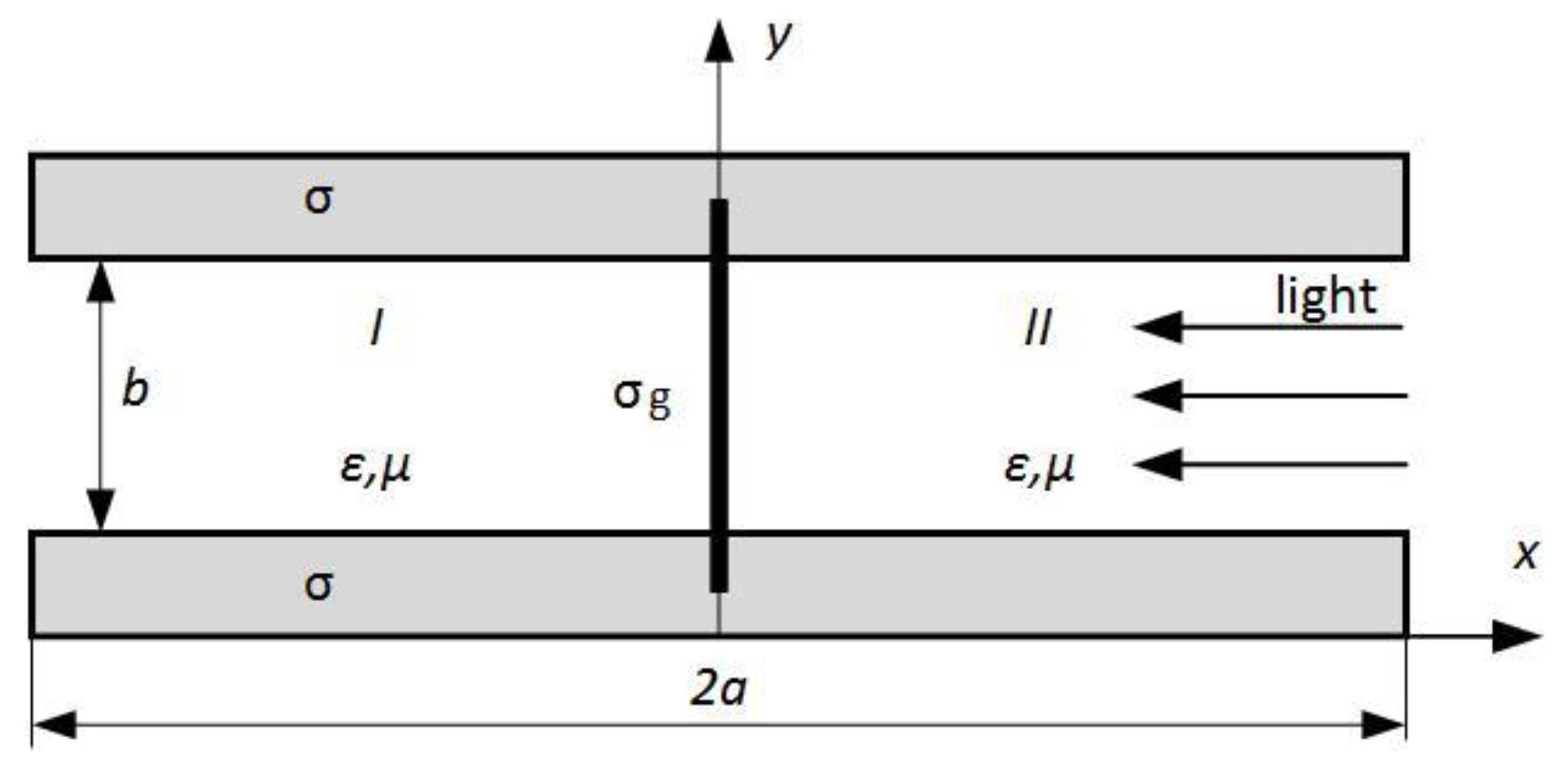
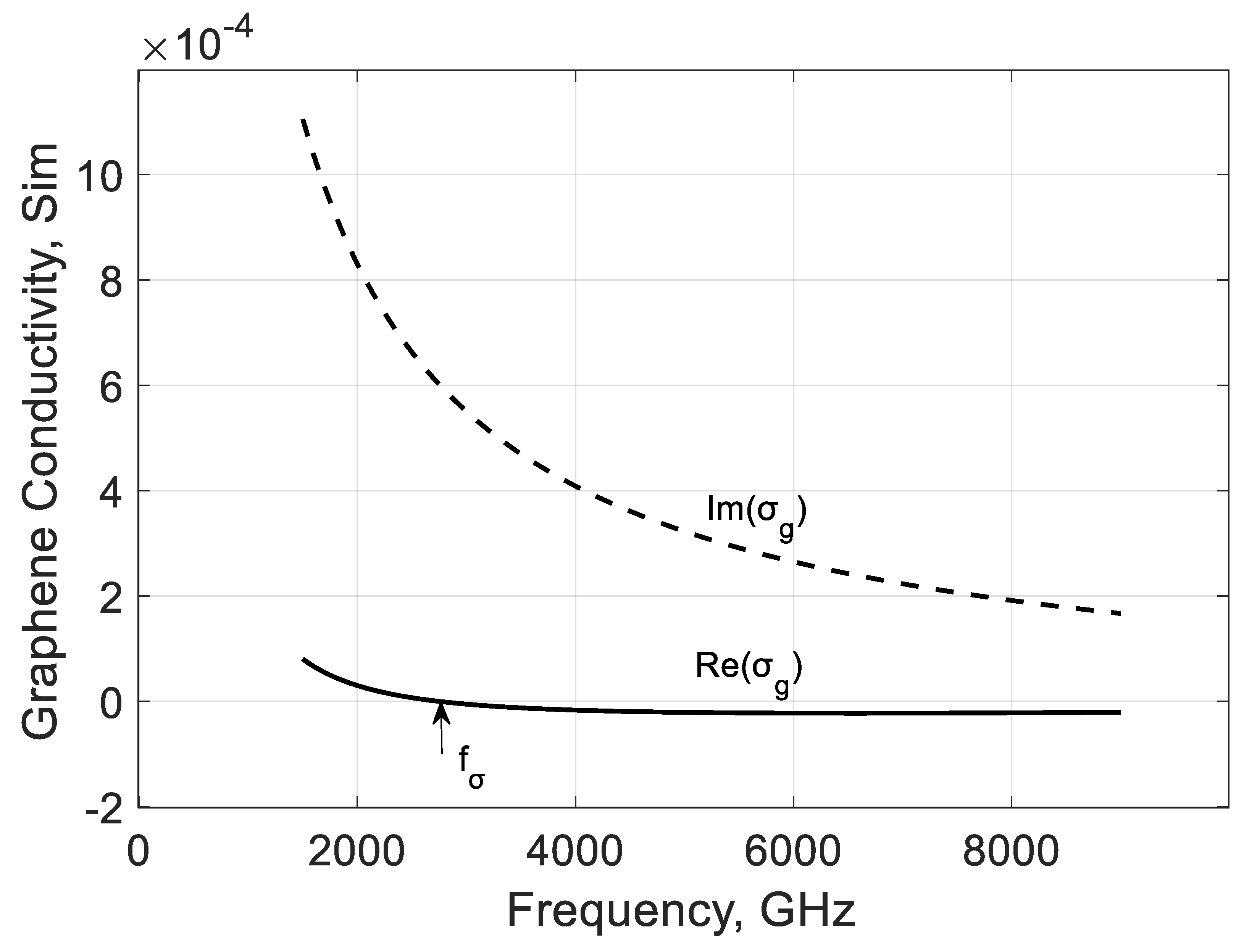
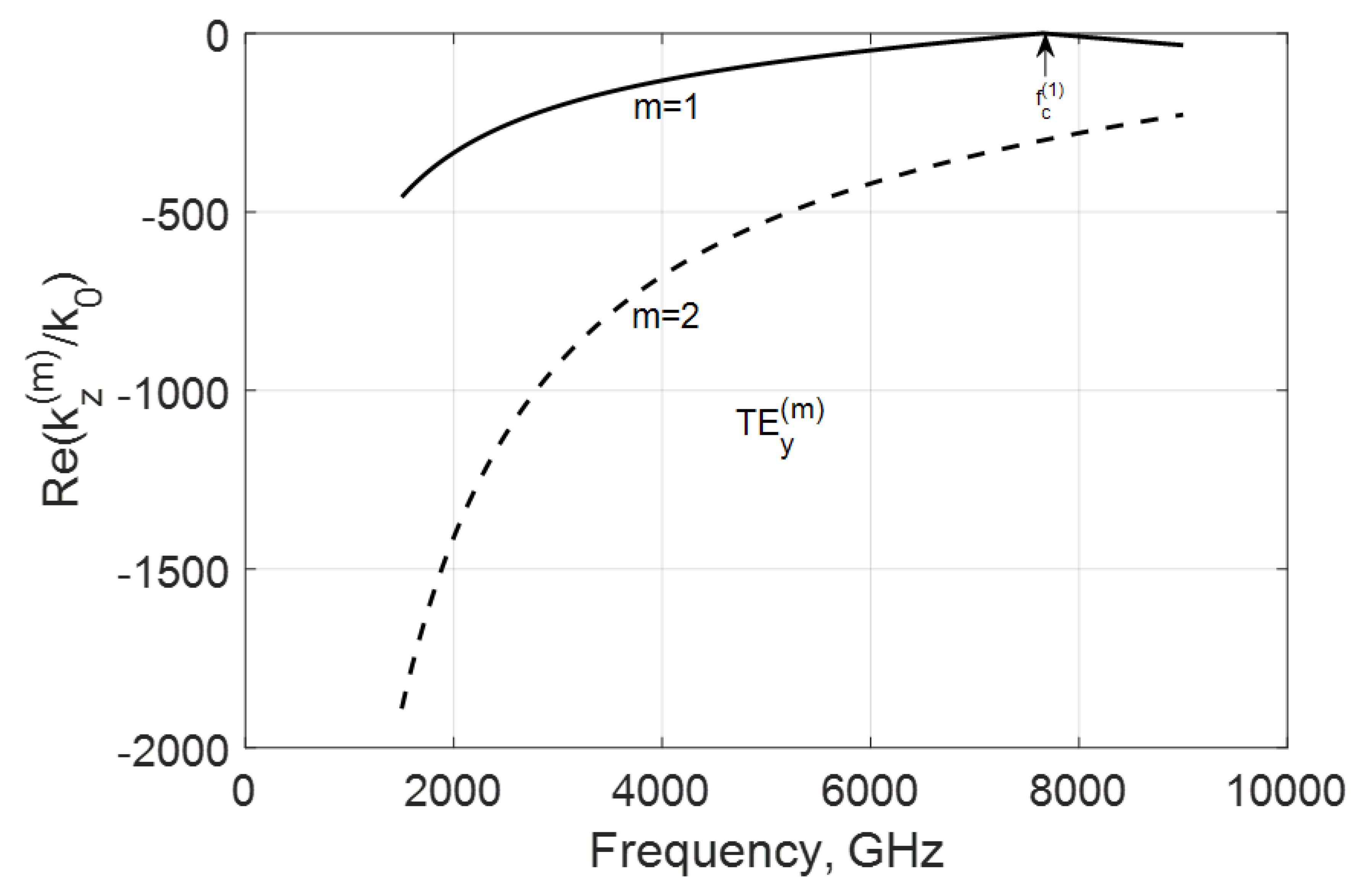


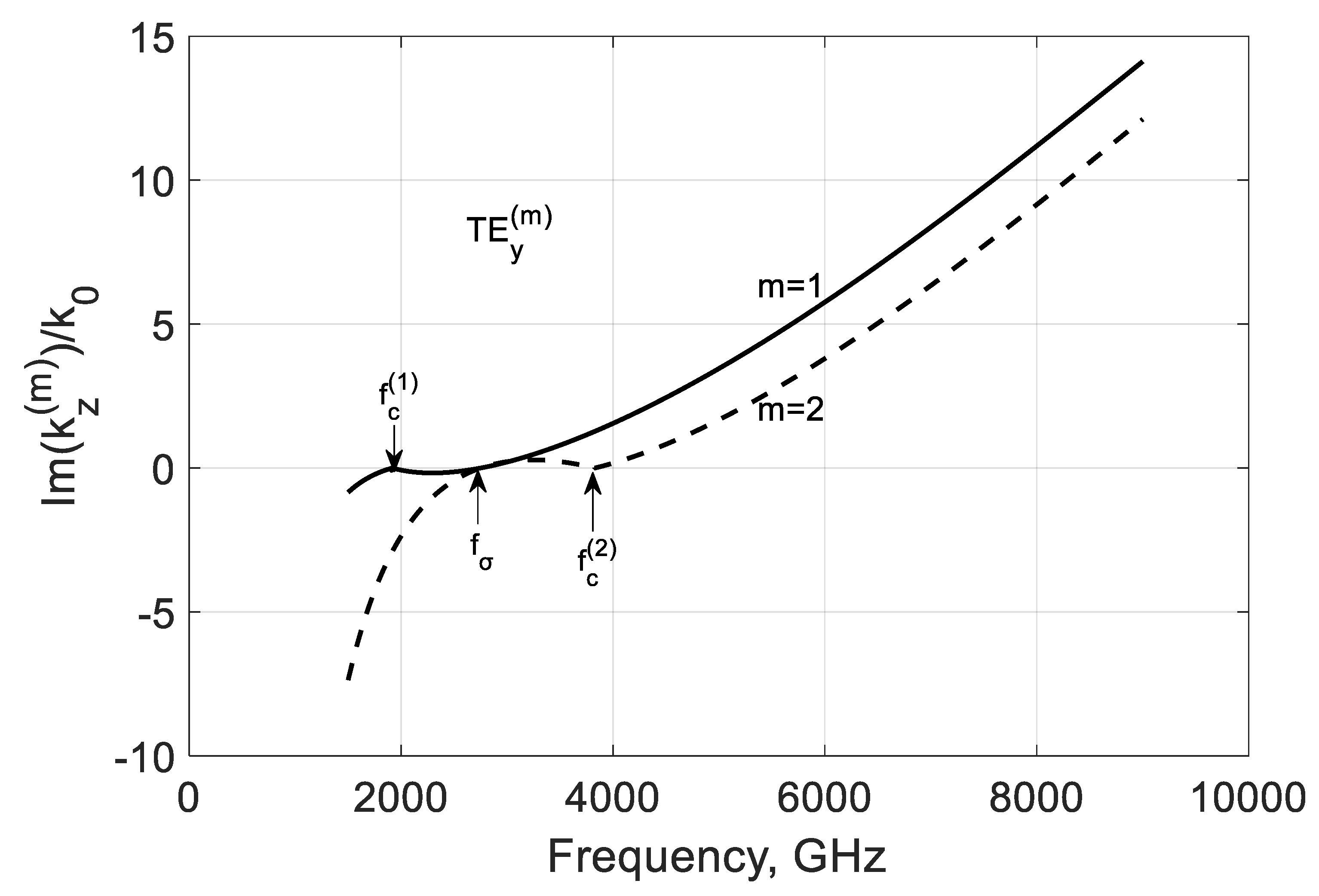
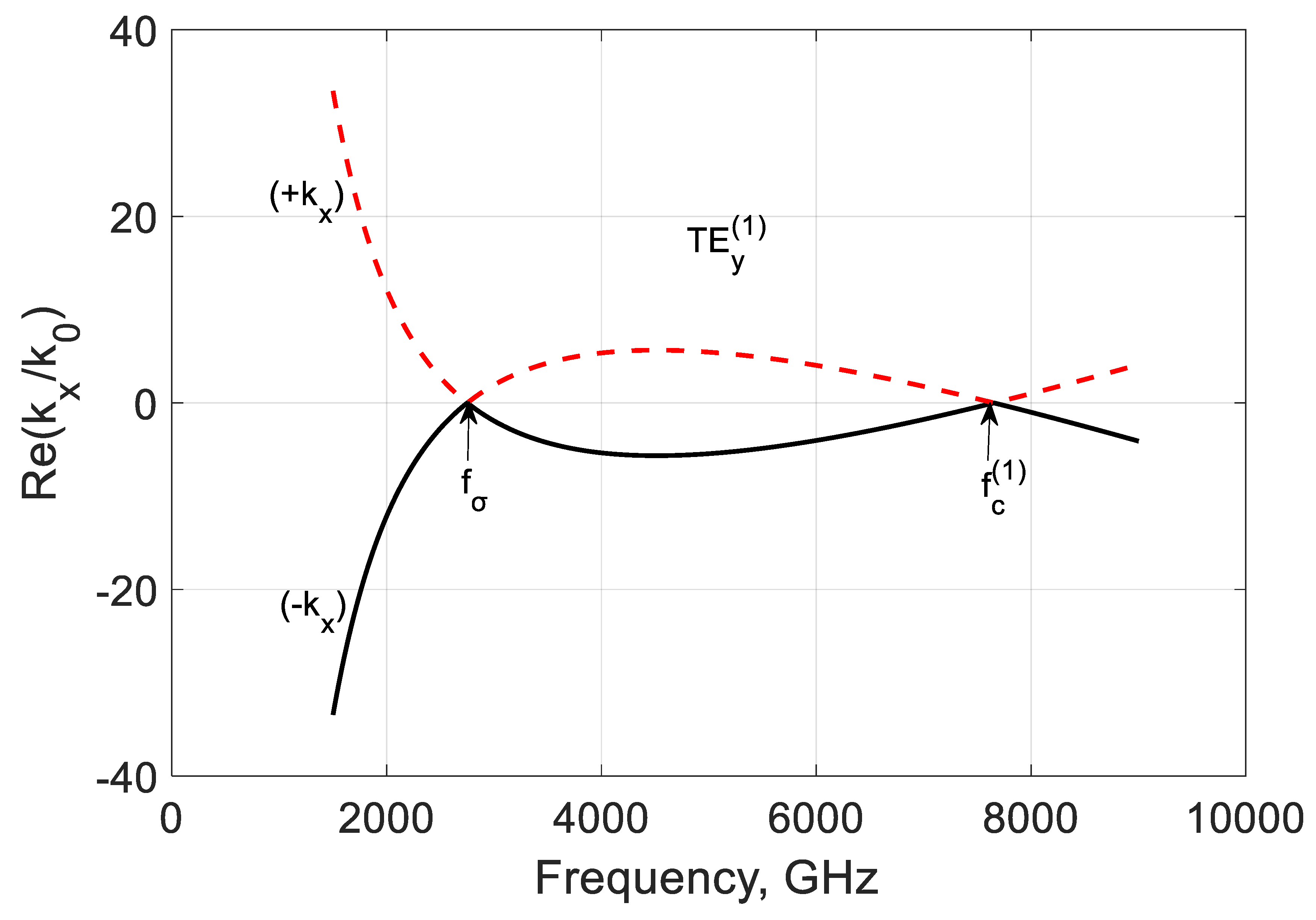
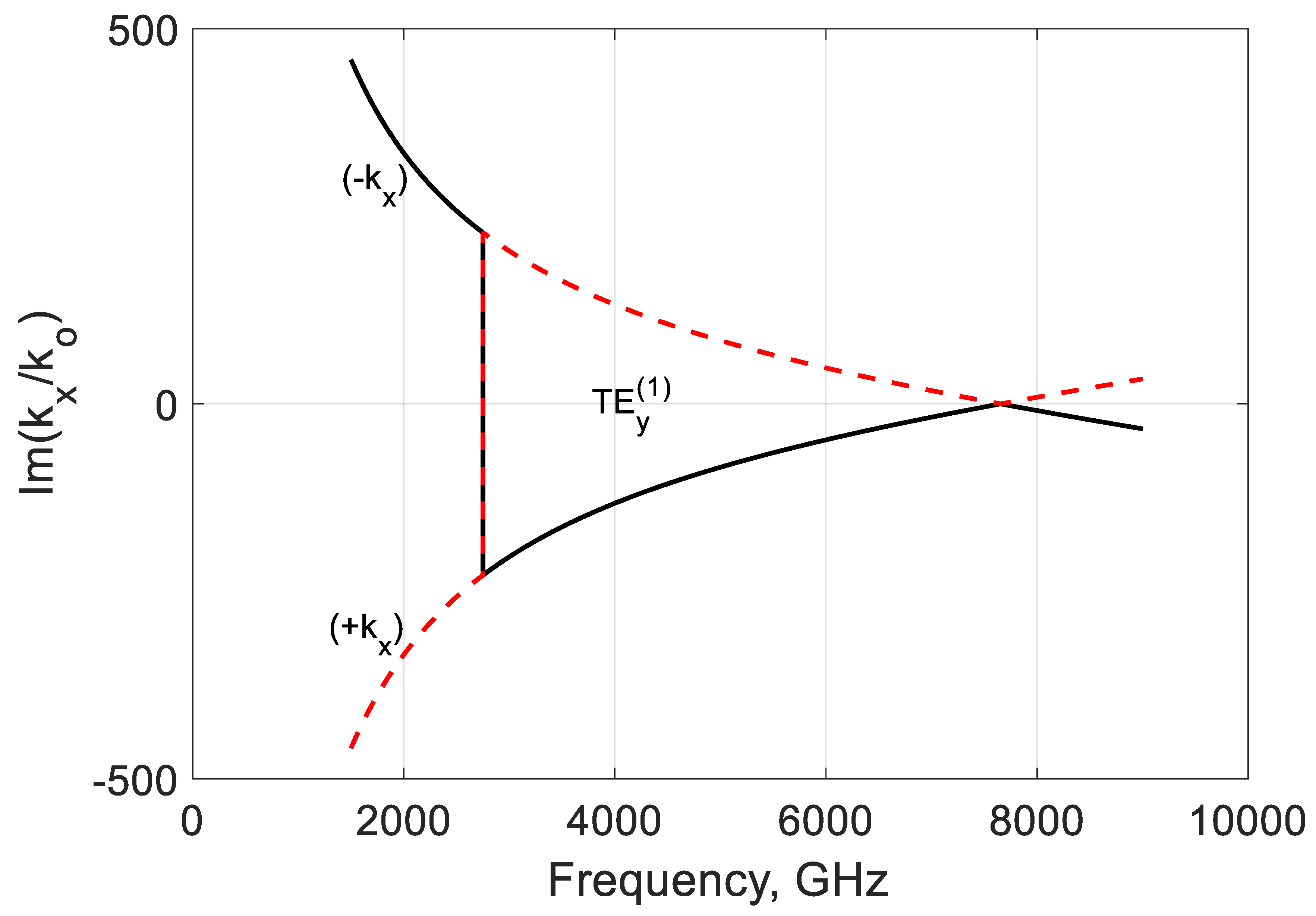
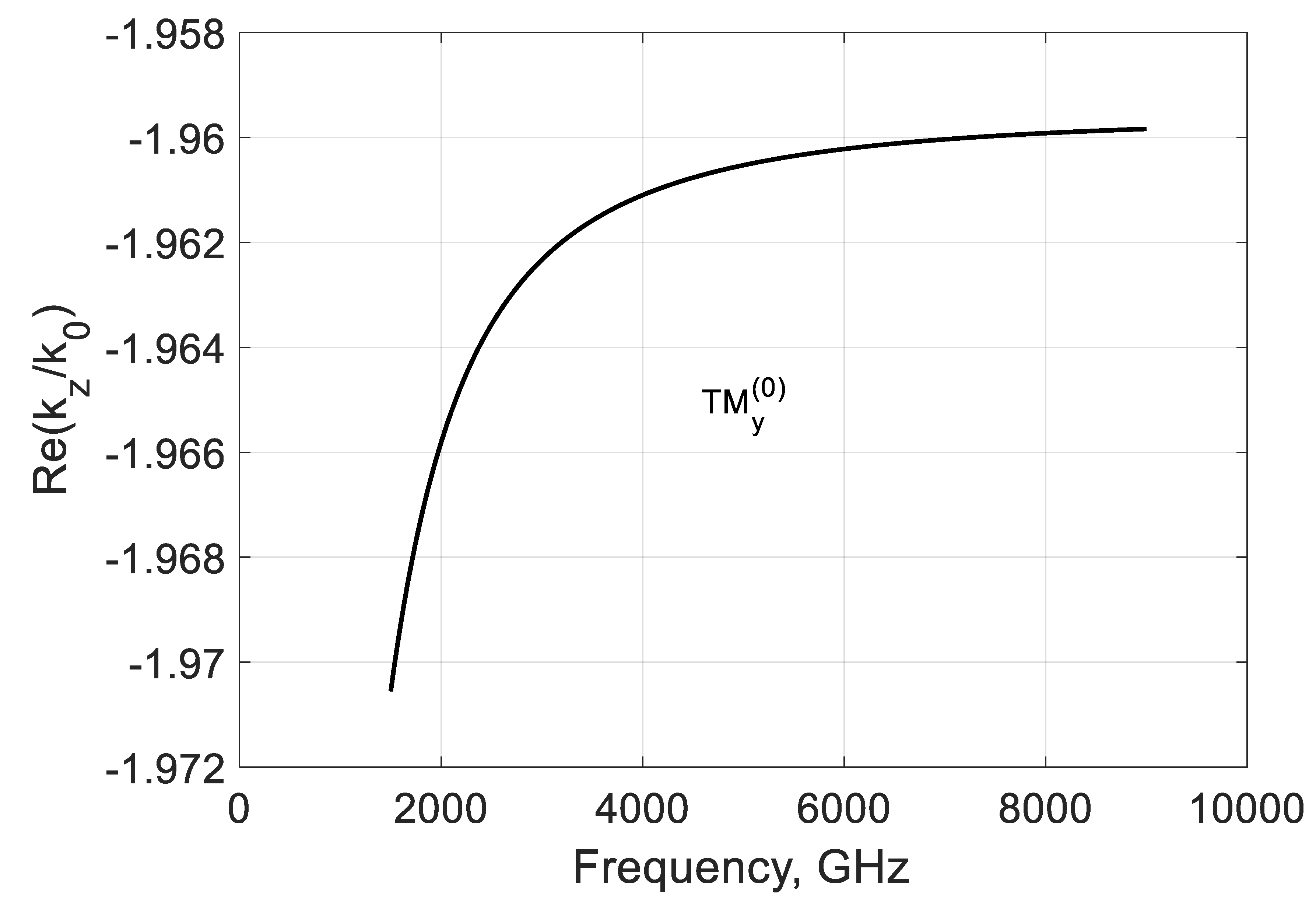
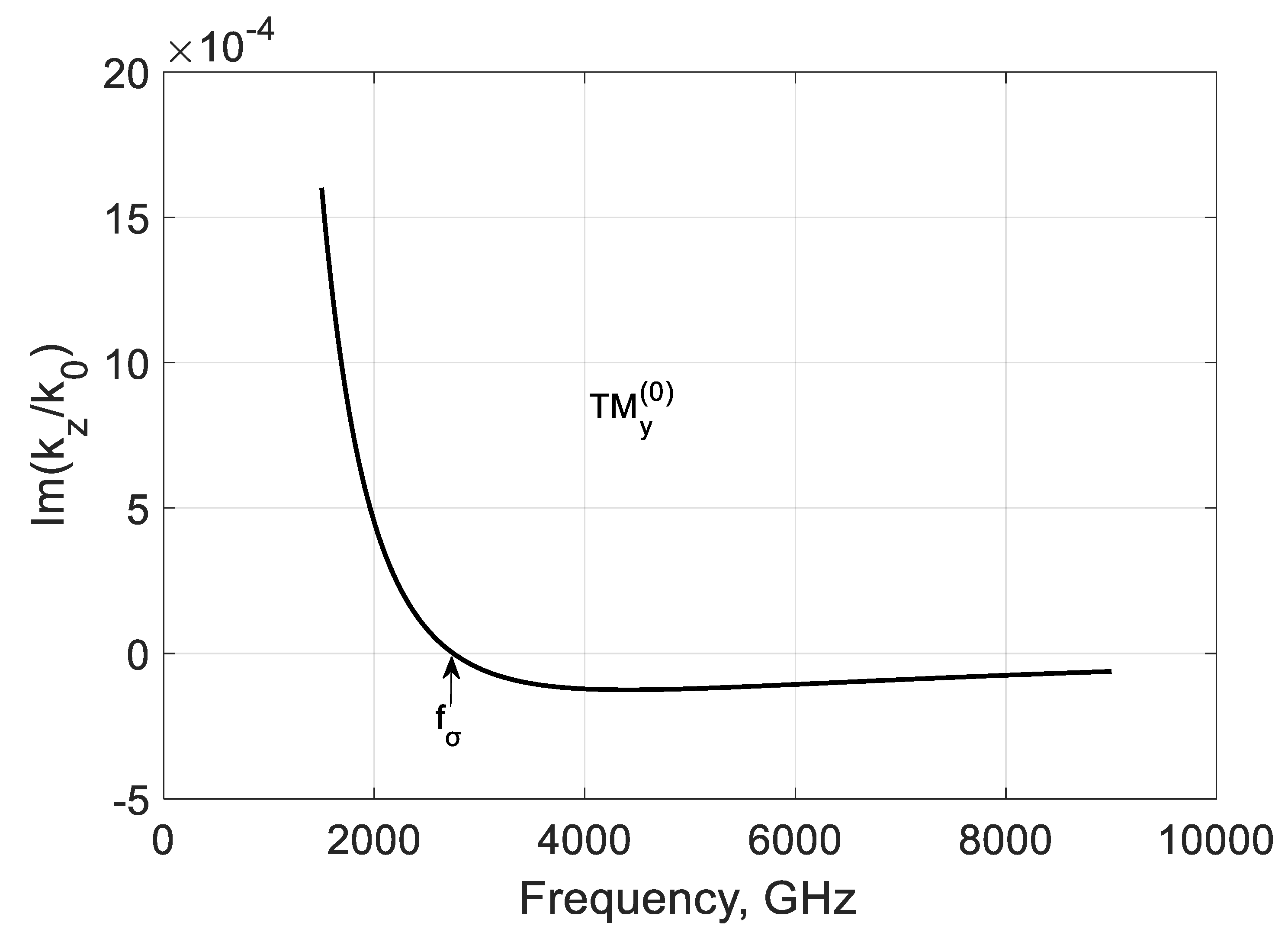
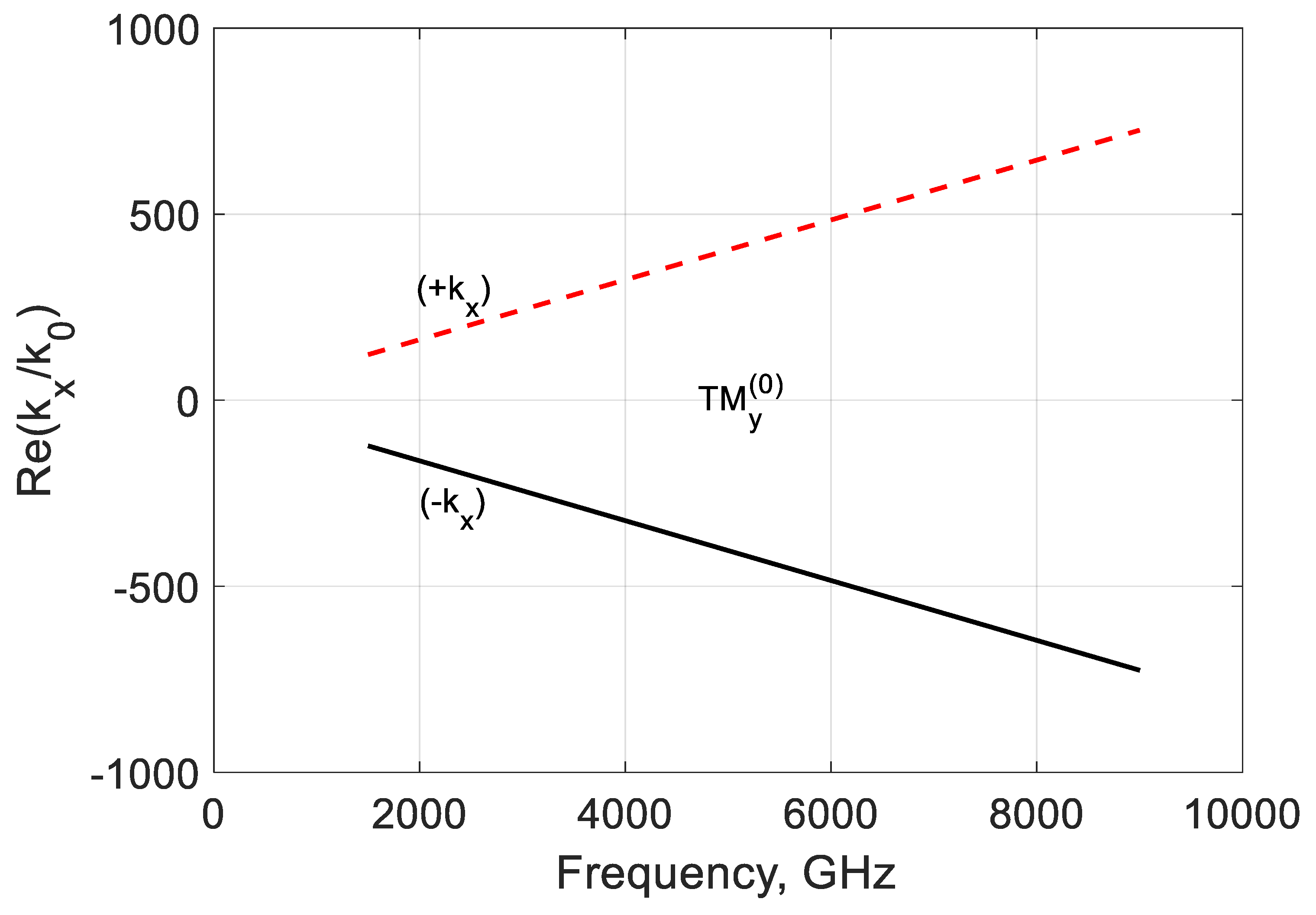
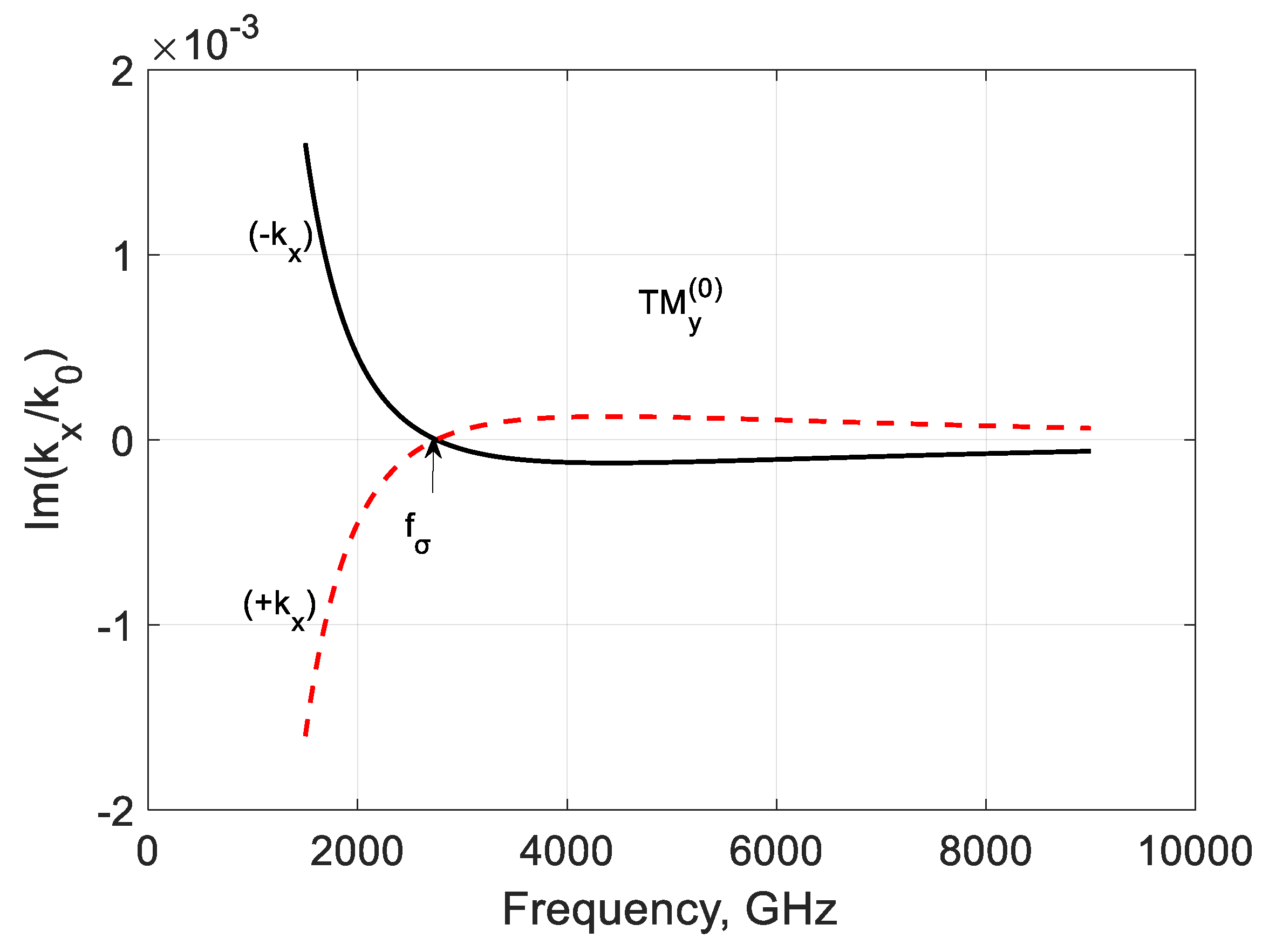
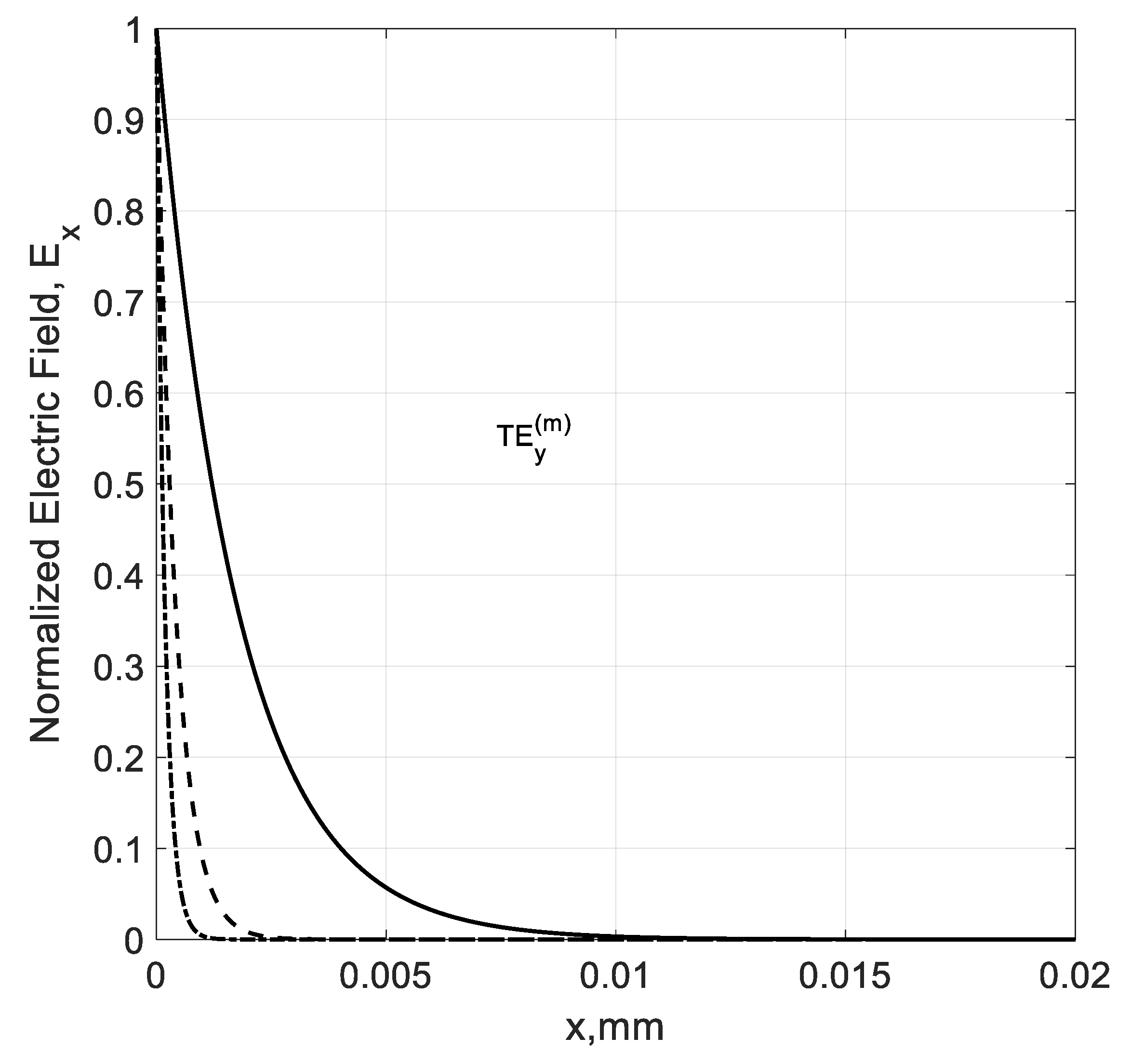
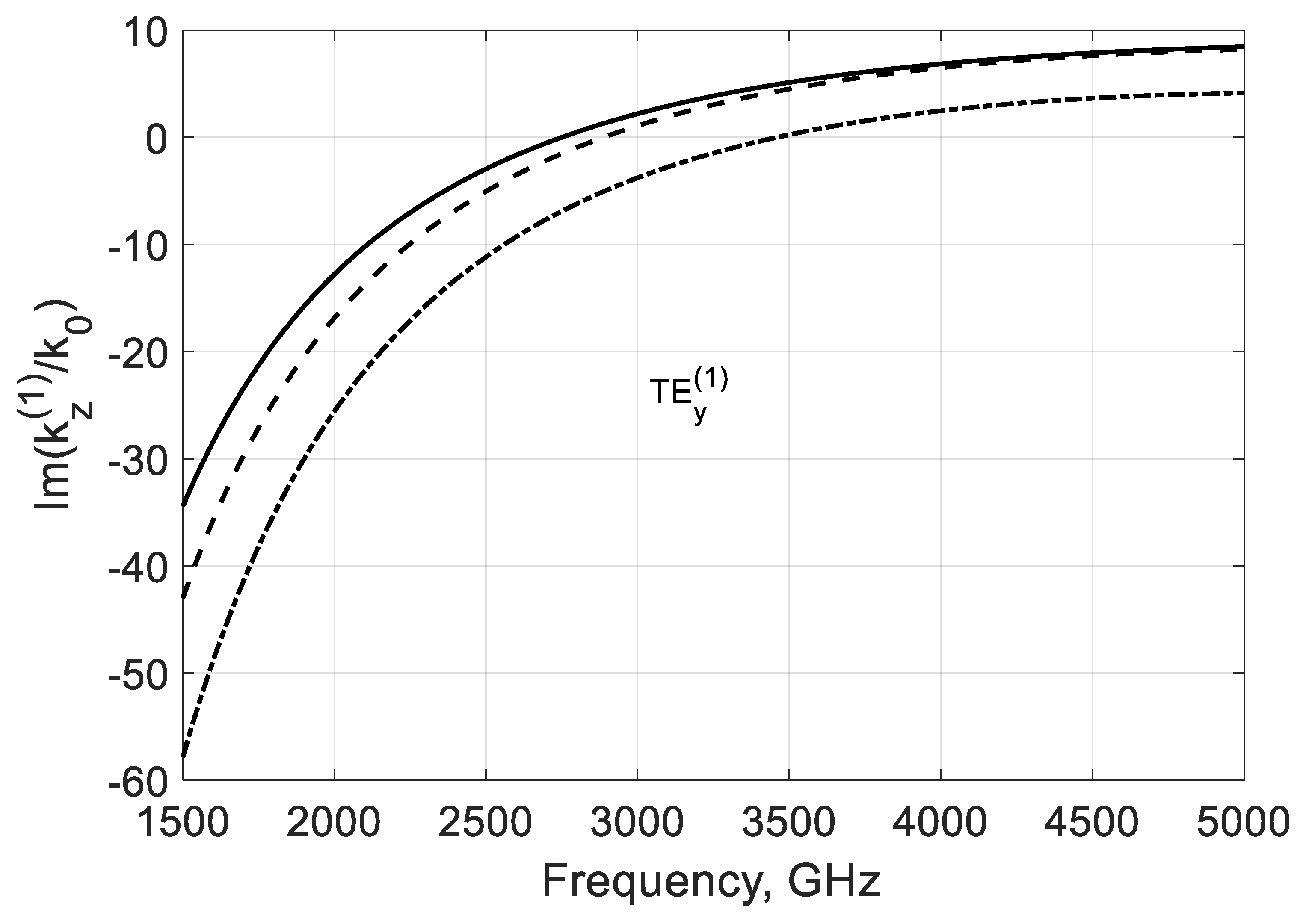
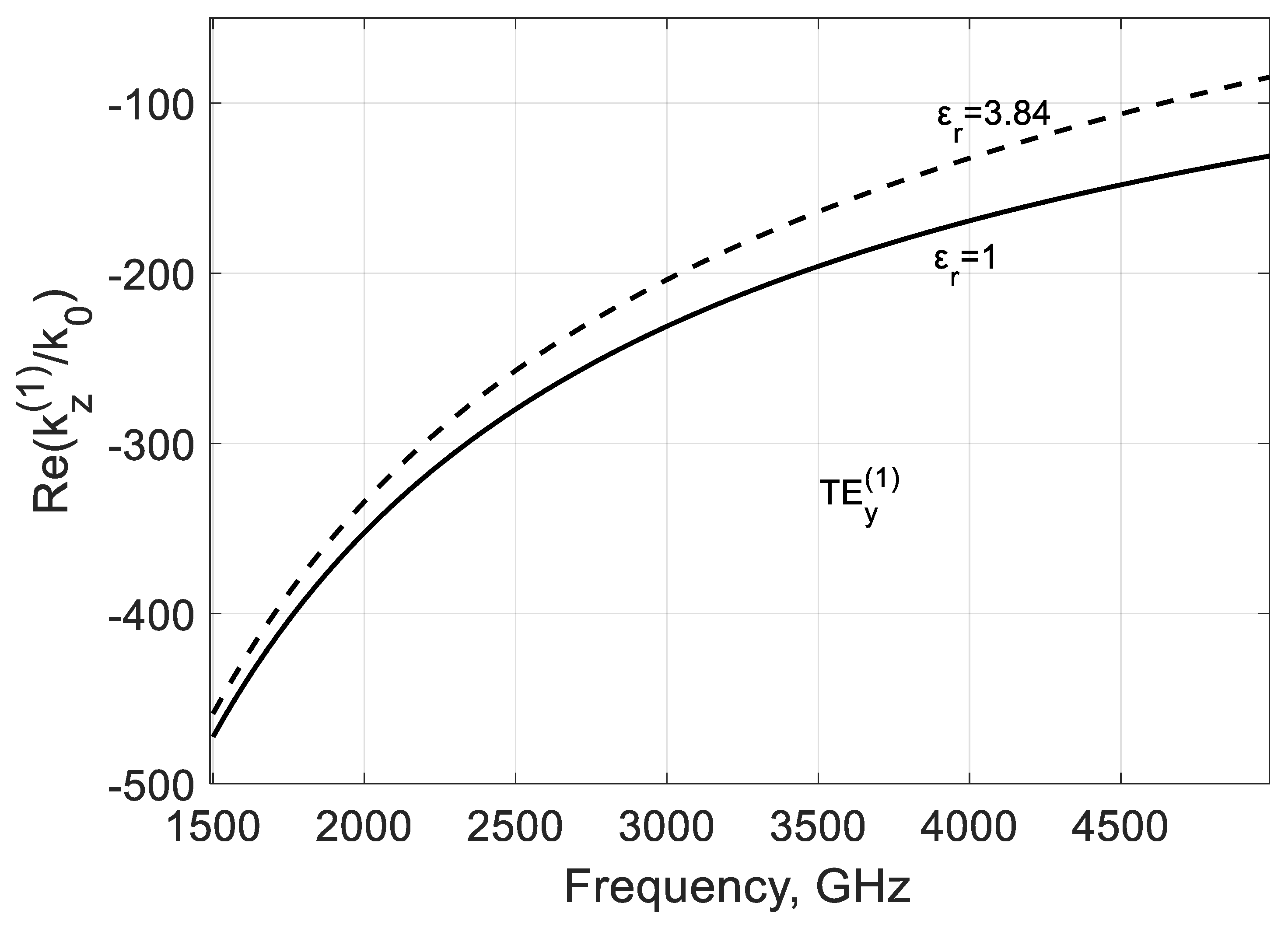


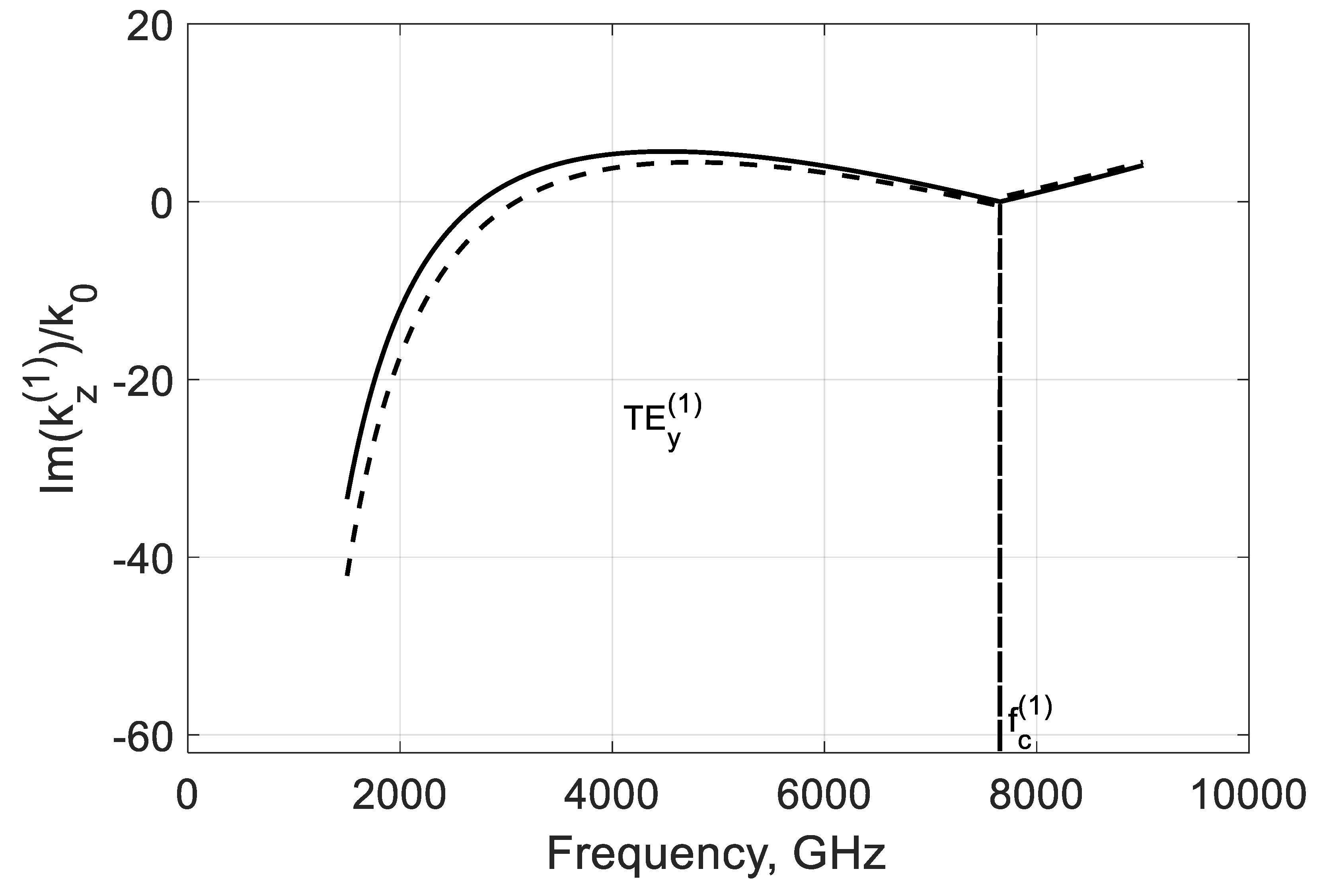

Publisher’s Note: MDPI stays neutral with regard to jurisdictional claims in published maps and institutional affiliations. |
© 2020 by the author. Licensee MDPI, Basel, Switzerland. This article is an open access article distributed under the terms and conditions of the Creative Commons Attribution (CC BY) license (http://creativecommons.org/licenses/by/4.0/).
Share and Cite
Kouzaev, G.A. Graphene H-Waveguide for Terahertz Lasing Applications: Electromagnetic Quasi-Linear Theory. Nanomaterials 2020, 10, 2415. https://doi.org/10.3390/nano10122415
Kouzaev GA. Graphene H-Waveguide for Terahertz Lasing Applications: Electromagnetic Quasi-Linear Theory. Nanomaterials. 2020; 10(12):2415. https://doi.org/10.3390/nano10122415
Chicago/Turabian StyleKouzaev, Guennadi A. 2020. "Graphene H-Waveguide for Terahertz Lasing Applications: Electromagnetic Quasi-Linear Theory" Nanomaterials 10, no. 12: 2415. https://doi.org/10.3390/nano10122415




